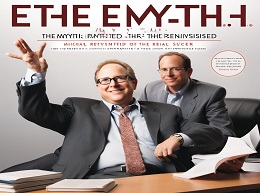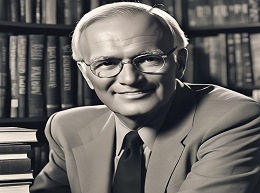The E-Myth Revisited

"The E-Myth Revisited" by Michael E. Gerber is a groundbreaking book that challenges conventional wisdom about entrepreneurship and offers a systematic framework for building successful businesses. Through compelling storytelling and practical insights, Gerber demystifies the entrepreneurial journey and reveals the key principles behind creating businesses that thrive. In this comprehensive review, we'll explore the core concepts of "The E-Myth Revisited," examine real-world examples of its application, and uncover how entrepreneurs can leverage these principles to achieve lasting success.
1. Understanding the Entrepreneurial Myth:
At the heart of "The E-Myth Revisited" is the concept of the entrepreneurial myth (E-Myth)—the misconception that entrepreneurs are born with an innate ability to build successful businesses. Gerber argues that this myth leads many aspiring entrepreneurs to pursue their dreams without the necessary skills, knowledge, or systems in place. Instead of thriving, they find themselves overwhelmed by the day-to-day demands of running a business, ultimately leading to burnout or failure.
Example:
Consider the story of Steve Jobs, the co-founder of Apple Inc. While Jobs is celebrated as one of the greatest entrepreneurs of our time, his success was not solely attributed to innate talent or luck. Jobs meticulously built Apple into a global powerhouse by implementing systematic processes, fostering a culture of innovation, and surrounding himself with talented individuals who shared his vision. Jobs's approach to entrepreneurship aligns with the principles outlined in "The E-Myth Revisited," emphasizing the importance of systems and processes in building successful businesses.
The Three Roles of the Entrepreneur:
"The E-Myth Revisited" introduces the concept of the three roles of the entrepreneur the Technician, the Manager, and the Entrepreneur. Gerber explains that successful entrepreneurs must balance these roles effectively to build and scale their businesses. The Technician is skilled at performing the technical work of the business, the Manager focuses on implementing systems and processes, and the Entrepreneur provides the vision and strategic direction.
Example:
Imagine a small bakery owned by an aspiring entrepreneur named Sarah. Sarah is a talented baker (Technician) who decides to start her own business. However, she soon finds herself overwhelmed by the day-to-day demands of running the bakery ordering supplies, managing employees, and dealing with customers. To overcome these challenges, Sarah must step into the roles of Manager and Entrepreneur, implementing systems for inventory management, employee training, and customer service, while also setting long-term goals and strategies for growth.
The Importance of Systems:
A central theme of "The E-Myth Revisited" is the importance of systems in building successful businesses. Gerber argues that systems provide the foundation for consistency, efficiency, and quality in operations. By documenting and standardizing every aspect of the business from sales and marketing to operations and customer service entrepreneurs can create scalable and replicable processes that drive sustainable growth.
Example:
Consider the success of McDonald's, the global fast-food chain known for its consistency and efficiency. McDonald's owes much of its success to its systematic approach to business operations. From the moment customers enter a McDonald's restaurant, they experience the same menu, the same service, and the same quality standards, regardless of location. This consistency is made possible by McDonald's meticulous attention to detail and its unwavering commitment to implementing and refining systems that ensure a seamless customer experience.
Working On the Business, Not In It:
"The E-Myth Revisited" emphasizes the importance of working on the business, not in it. Gerber argues that many entrepreneurs become trapped in the day-to-day operations of their businesses, neglecting strategic planning and long-term growth. Instead, entrepreneurs should focus on developing systems, setting goals, and creating a vision for the future.
Example:
Imagine a small landscaping company owned by an entrepreneur named John. Initially, John spends most of his time working in the field, mowing lawns, and pruning shrubs. However, as the business grows, John realizes that he needs to step back and focus on working on the business. He hires additional workers to handle day-to-day operations and spends his time developing marketing strategies, expanding services, and building relationships with clients. By working on the business, John is able to scale his company and achieve greater success.
Embracing the Entrepreneurial Mindset:
"The E-Myth Revisited" encourages entrepreneurs to embrace the entrepreneurial mindset a mindset characterized by innovation, creativity, and a willingness to take calculated risks. Gerber argues that successful entrepreneurs are those who are not afraid to challenge the status quo, think outside the box, and pursue their dreams with passion and determination.
Example:
Consider the story of Elon Musk, the visionary entrepreneur behind SpaceX, Tesla, and other groundbreaking ventures. Musk's success can be attributed in part to his entrepreneurial mindset—he is unafraid to tackle ambitious projects, take risks, and disrupt entire industries. Musk's willingness to push the boundaries of innovation has led to numerous breakthroughs, from reusable rockets to electric vehicles, demonstrating the transformative power of the entrepreneurial mindset.
In conclusion, "The E-Myth Revisited" by Michael E. Gerber is a must-read for aspiring entrepreneurs and business owners seeking to build successful and sustainable ventures. Through its practical insights and timeless principles, "The E-Myth Revisited" offers a roadmap for navigating the challenges of entrepreneurship and achieving lasting success. By understanding the entrepreneurial myth, embracing systematic approaches, and cultivating an entrepreneurial mindset, entrepreneurs can build businesses that thrive in today's competitive landscape.












